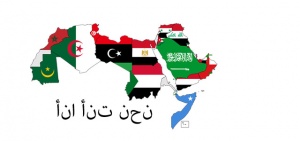Difference between revisions of "Language/Standard-arabic/Grammar/Subject-pronouns"
< Language | Standard-arabic | Grammar
Jump to navigation
Jump to search
(The Arabic Pronouns) |
|||
| Line 1: | Line 1: | ||
[[File:arabic-pronouns.jpg|thumb]] | |||
Hello Arabic learners, | |||
In today's lesson, we will talk about the pronouns in Arabic. | |||
معا في شرح قواعد اللغة العربية | معا في شرح قواعد اللغة العربية | ||
==Pronouns== | ==Pronouns== | ||
The Arabic | The Arabic language has pronouns for males and females as following: | ||
===I=== | |||
* I: pronounced as " Ana" it's equal for male and female. it's written as '''أنا''' | |||
===You=== | |||
* You: pronounced as "Anta" for male and "Anty" for female. it's written as '''أنت - أنتي''' | |||
*You (masc) = أنت = anta | *You (masc) = أنت = anta | ||
*You (fem) = أنت = anti | *You (fem) = أنت = anti | ||
| Line 20: | Line 21: | ||
*You (plural, masc) = أنتم = antum | *You (plural, masc) = أنتم = antum | ||
*You (plural, fem) = أنتن = antunna | *You (plural, fem) = أنتن = antunna | ||
*We = | ===We=== | ||
*He | * We: pronounced as "nahno" for both males and females. it's written as '''نحن''' | ||
*She = | |||
===He/She=== | |||
* He: pronounced as "Hoowa" it's written as '''هو''' | |||
* She: pronounced as "Heya" it's written as '''هى''' | |||
===They=== | |||
*They (dual) = هما = humma | *They (dual) = هما = humma | ||
*They (plural,masc) = هم = hom | *They (plural,masc) = هم = hom | ||
Revision as of 16:11, 27 November 2020
Hello Arabic learners,
In today's lesson, we will talk about the pronouns in Arabic.
معا في شرح قواعد اللغة العربية
Pronouns
The Arabic language has pronouns for males and females as following:
I
- I: pronounced as " Ana" it's equal for male and female. it's written as أنا
You
- You: pronounced as "Anta" for male and "Anty" for female. it's written as أنت - أنتي
- You (masc) = أنت = anta
- You (fem) = أنت = anti
- You (dual) = أنتما = antuma
- You (plural, masc) = أنتم = antum
- You (plural, fem) = أنتن = antunna
We
- We: pronounced as "nahno" for both males and females. it's written as نحن
He/She
- He: pronounced as "Hoowa" it's written as هو
- She: pronounced as "Heya" it's written as هى
They
- They (dual) = هما = humma
- They (plural,masc) = هم = hom
- They (plural,fem) = هن = hunna
Use
In arabic they are frequently dropped except in the equational (verbless) sentences like:
- I'm happy = أنا سعيد
- I'm from َAlgeria = أنا من الجزائر
- He is from Egypt = هــو من مـِصر
